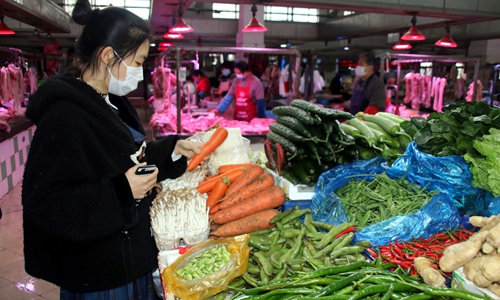
A woman selects vegetables in a market in Suzhou, East China's Jiangsu Province. (Photo: IC)
As the Trump administration may soon send cash to American workers following its drastic measures to calm domestic markets, Chinese experts doubted the policy's effects, as the stimulus package offers relief while voucher programs in China would be effective in bringing about a consumption revival, if rolled out properly.
Such different ways to stabilize and boost their economies would achieve different effects, as China and the US are at different stages in fighting the coronavirus, Tian Yun, vice director of the Beijing Economic Operation Association, told the Global Times on Wednesday.
Tian said that $1,000 per American adult might be insufficient, since the current US medical care capacity to deal with the coronavirus has brought about great financial stress to low- and medium-income Americans.
The White House is planning to send an $850 billion stimulus package to stabilize its economy. "Americans need cash now and the president wants to get cash now," US Treasury Secretary Steven Mnuchin said at Tuesday's press conference.
However, "by doing this, the US will likely print more dollars, with a net effect that the rest of the world will pay for the economic stability of the US, as the dollar would weaken, hurting countries that hold dollar reserves," an analyst told the Global Times on condition of anonymity.
In China, various cities have introduced voucher programs to enhance the confidence of consumers and encourage them to spend more as the epidemic prevention and control work achieves remarkable progress in China.
Jinan in East China's Shandong Province announced on March 2 plans to issue vouchers of 20 million yuan ($2.8 million) to its residents in a bid to facilitate spending, following a dormant retail month caused by the virus outbreak in China.
Soon, Nanjing, capital city of East China's Jiangsu Province issued vouchers of 318 million yuan and Ningbo in East China's Zhejiang Province issued vouchers of 100 million yuan in recent days. Local residents can use the vouchers in cinemas, restaurants, bookstores, hotels, gyms and tourism facilities.
"Local governments issued vouchers through public channels, which not only attracted a wide range of consumers, but also amounted to a government endorsement, indicating that the health conditions of the public places shown on vouchers are guaranteed, making people feel safe to consume," Hu Qimu, a senior fellow at the Sinosteel Economic Research Institute, told the Global Times on Wednesday.
Local governments should consider rolling out vouchers according to their own needs and in targeted industries that are waiting to be revived urgently, experts advised, adding consumers' confidence in their local public health systems is important.
Though they don't think the central government of China will issue vouchers on the national level, some said vouchers valued at 150 to 200 billion yuan would soon stimulate domestic consumption.
"Chinese people are gradually recovering their consumption in the services sector while the American people will take the money for urgent need. Once Americans get the money, I believe they would rush to the supermarket and scramble for daily necessities," he said.
It is notable that consumer spending accounts for about 70 percent of US economic activity. By comparison, consumer spending contributed 76.2 percent to China's GDP growth in 2018, making it the largest driver of the country's economic growth for six consecutive years.
However, US retail sales declined by 0.5 percent in February, the largest dive since December 2018, according to statistics released by the US Commerce Department on Tuesday.
Estimates suggested that COVID-19 cases in the US will peak in April or May. "The chilling effects brought by the virus may bring about great social unrest as Americans have guns," Tian said. He predicted the US services sector will drop by 50 percent if the coronavirus outbreak comes in April or May, while it will also be the time for China to bring back its consumption revival.


